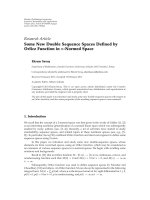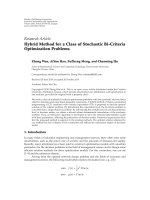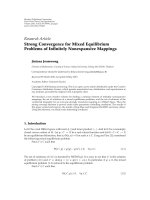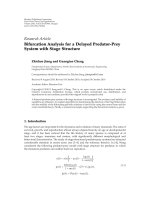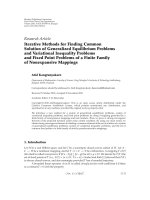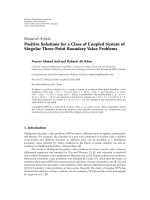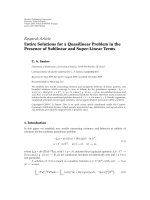Báo cáo hóa học: " Research Article Some Results for a Finite Family of Uniformly L-Lipschitzian Mappings in Banach Spaces" pdf
Bạn đang xem bản rút gọn của tài liệu. Xem và tải ngay bản đầy đủ của tài liệu tại đây (491.3 KB, 8 trang )
Hindawi Publishing Corporation
Fixed Point Theory and Applications
Volume 2007, Article ID 58494, 8 pages
doi:10.1155/2007/58494
Research Article
Some Results for a Finite Family of Uniformly L-Lipschitzian
Mappings in Banach Spaces
Shih-Sen Chang, Jia Lin Huang, and Xiong Rui Wang
Received 21 April 2007; Accepted 14 June 2007
Recommended by Massimo Furi
The purpose of this paper is to prove a strong convergence theorem for a finite family of
uniformly L-Lipschitzian mappings in Banach spaces. The results presented in the paper
not only correct some mistakes appeared in the paper by Ofoedu (2006) but also improve
and extend some recent results by Chang (2001), Cho et al. (2005), Ofoedu (2006), Schu
(1991), and Zeng (2003, 2005).
Copyright © 2007 Shih-Sen Chang et al. This is an open access article distributed under
the Creative Commons Attribution License, which permits unrestricted use, distribution,
and reproduction in any medium, provided the original work is properly cited.
1. Introduction and preliminaries
Throughout this paper, we assume that E is a real Banach space, E
∗
is the dual space of
E, K is a nonempty closed convex subset of E,andJ : E
→ 2
E
∗
is the normalized duality
mapping defined by
J(x)
=
f ∈ E
∗
: x, f =x
2
=f
2
, f =x
, x ∈ E, (1.1)
where
·,· denotes the duality pairing between E and E
∗
. The single-valued nor malized
duality mapping is denoted by j.
Definit ion 1.1. Let T : K
→ K be a mapping.
(1) T is said to be uniformly L-Lipschitzian if there exists L>0 (without loss of
generality, a ssume that L
≥ 1) such that for any x, y ∈ K,
T
n
x − T
n
y
≤
Lx − y∀n ≥ 1; (1.2)
2 Fixed Point Theory and Applications
(2) T is said to be asymptotically nonexpansive if there exists a sequence
{k
n
}⊂
[1,∞)withk
n
→ 1suchthatforanygivenx, y ∈ K,
T
n
x − T
n
y
≤
k
n
x − y∀n ≥ 1; (1.3)
(3) T is said to be asymptotically pseudocontractive if there exists a sequence
{k
n
}⊂
[1,∞)withk
n
→ 1suchthat,foranyx, y ∈ K, there exists j(x − y) ∈ J(x − y):
T
n
x − T
n
y, j(x − y)
≤
k
n
x − y
2
∀n ≥ 1. (1.4)
Remark 1.2. (1) It is easy to see that if T is an asymptotically nonexpansive mapping, then
T is a uniformly L-Lipschitzian mapping, where L
= sup
n≥1
k
n
,andeveryasymptotically
nonexpansive mapping is asymptotically pseudocontractive, but the inverse is not true,
in general.
(2) The concept of asymptotically nonexpansive mappings was introduced by Goebel
and Kirk [1], while the concept of asymptotically pseudocontractive mappings was intro-
duced by Schu [2] who proved the following theorem.
Theorem 1.3 (Schu [2]). Let H be a Hilbert space, let K be a nonempty bounded closed
convex subset of H,andletT : K
→ K be a completely continuous, uniformly L-Lipschitzian,
and asymptotically pseudocontractive mapping with a s equence
{k
n
}⊂[1,∞) satisfying the
following conditions:
(i) k
n
→ 1 as n →∞;
(ii)
∞
n=1
q
2
n
− 1 < ∞,whereq
n
= 2k
n
− 1.
Suppose further that
{α
n
} and {β
n
} are two sequences in [0,1] such that ε<α
n
<b,for
all n
≥ 1,whereε>0 and b ∈ (0, L
−2
[(1 + L
2
)
1/2
− 1]) are some posit ive numbers. For any
x
1
∈ K,let{x
n
} be the iterative sequence defined by
x
n+1
=
1 − α
n
x
n
+ α
n
T
n
x
n
∀n ≥ 1. (1.5)
Then,
{x
n
} converges strongly to a fixed point of T in K.
In [3], the first author extended Theorem 1.3 to a real uniformly smooth Banach space
and proved the following theorem.
Theorem 1.4 (Chang [3]). Le t E be a uniformly smooth Banach space, let K be a nonempty
boundedclosedconvexsubsetofE,andletT : K
→ K be an asymptotically pseudocontractive
mapping with a sequence
{k
n
}⊂[1,∞), k
n
→ 1,andF(T) =∅,whereF(T) is the set of
fixed points of T in K.Let
{α
n
} beasequencein[0,1] satisfying the following conditions:
(i) α
n
→ 0;
(ii)
∞
n=0
α
n
=∞.
For any x
0
∈ K,let{x
n
} be the iterative sequence defined by
x
n+1
=
1 − α
n
x
n
+ α
n
T
n
x
n
∀n ≥ 0. (1.6)
Shih-Sen Chang et al. 3
If there exists a str ict increasing function φ :[0,
∞) → [0,∞) with φ(0) = 0 such that
T
n
x
n
− x
∗
, j
x
n
− x
∗
≤
k
n
x
n
− x
∗
2
− φ
x
n
− x
∗
∀
n ≥ 0, (1.7)
where x
∗
∈ F(T) is some fixed point of T in K, then x
n
→ x
∗
as n →∞.
Very recently, in [4] Ofoedu proved the following theorem.
Theorem 1.5 (Ofoedu [4]). Let E be a real Banach space, let K be a nonempty closed convex
subset of E,andletT : K
→ K be a uniformly L-Lipschitzian asymptotically pseudocontrac-
tive mapping with a sequence
{k
n
}⊂[1,∞), k
n
→ 1, such that x
∗
∈ F(T),whereF(T) is
the set of fixed points of T in K.Let
{α
n
} beasequencein[0,1] satisfying the following
conditions:
(i)
∞
n=0
α
n
=∞;
(ii)
∞
n=0
α
2
n
< ∞;
(iii)
∞
n=0
α
n
(k
n
− 1) < ∞.
For any x
0
∈ K,let{x
n
} be the iterative sequence defined by
x
n+1
=
1 − α
n
x
n
+ α
n
T
n
x
n
∀n ≥ 0. (1.8)
If there exists a str ict increasing function φ :[0,
∞) → [0,∞) with φ(0) = 0 such that
T
n
x − x
∗
, j
x − x
∗
≤
k
n
x − x
∗
2
− φ
x − x
∗
∀
x ∈ K, (1.9)
then
{x
n
} converges strongly to x
∗
.
Remark 1.6. It should be pointed out that although Theorem 1.5 extends Theorem 1.4
from a real uniformly smooth Banach space to an arbitrary real Banach space and re-
moves the boundedness condition imposed on K, but the proof of [4, Theorem 3.1] has
some problems.
The purpose of this paper is, by using a simple and quite different method, to prove
some strong convergence theorems for a finite family of L-Lipschitzian mappings in stead
of the assumption that T is a uniformly L-Lipschitzian and asymptotically pseudocon-
tractive mapping in a Banach space. Our results not only correct some mistakes appeared
in [4] but also extend and improve some recent results in [2–7].
For this purpose, we first give the following lemmas.
Lemma 1.7 (Change [8]). Let E be a real Banach space and let J : E
→ 2
E
∗
be the normalized
duality mapping. Then, for any x, y
∈ E,
x + y
2
≤x
2
+2
y, j(x + y)
∀
j(x + y) ∈ J(x + y). (1.10)
Lemma 1.8 (Moore and Nnoli [9]). Let {θ
n
} be a sequence of nonnegative real numbers
and let
{λ
n
} be a real s equence sat isfying the following conditions:
0
≤ λ
n
≤ 1,
∞
n=0
λ
n
=∞. (1.11)
4 Fixed Point Theory and Applications
If there exists a strictly increasing function φ :[0,
∞) → [0,∞) such that
θ
2
n+1
≤ θ
2
n
− λ
n
φ
θ
n+1
+ σ
n
∀n ≥ n
0
, (1.12)
where n
0
is some nonnegative integer and {σ
n
} is a sequence of nonnegative number such
that σ
n
=◦(λ
n
), then θ
n
→ 0 as n →∞.
2. Main results
Definit ion 2.1. Let E be real Banach space, let K be a nonempty closed convex subset, and
let T
i
: K → K, i = 1,2, ,N be a finite family of mappings. {T
i
, i = 1,2, ,N} is called
afinitefamilyofuniformlyL-Lipschitzian mappings if there exists a positive constant L
(without loss of generality, assume that L
≥ 1) such that for all x, y ∈ K,
T
n
i
x − T
n
i
y
≤
Lx − y∀n ≥ 1, i = 1,2, ,N. (2.1)
The following theorem is the main result in this paper.
Theorem 2.2. Let E be a real Banach space, le t K be a nonempty closed convex subset of
E,andletT
i
: K → K, i = 1,2, ,N be a finite family of uniformly L-Lipschitzian mappings
with
N
i
=1
F(T
i
) =∅,whereL ≥ 1 is a constant and F(T
i
) is the set of fixed points of T
i
in
K.Letx
∗
be a given point in
N
i
=1
F(T
i
) and let {k
n
}⊂[1,∞) be a sequence with k
n
→ 1.
Let
{α
n
} and {β
n
} be two sequences in [0, 1] satisfying the following conditions:
(i) α
n
→ 0, β
n
→ 0(as n →∞);
(ii)
∞
n=0
α
n
=∞.
For any x
1
∈ K,let{x
n
} be the iterative sequence defined by
x
n+1
=
1 − α
n
x
n
+ α
n
T
n
n
y
n
∀n ≥ 1,
y
n
=
1 − β
n
x
n
+ β
n
T
n
n
x
n
∀n ≥ 1,
(2.2)
where T
n
n
= T
n
n(modN)
. If there exists a str ict increasing function φ :[0,∞) → [0,∞) with
φ(0)
= 0 such that for any x ∈ K,
T
n
n
x − x
∗
, j
x − x
∗
≤
k
n
x − x
∗
2
− φ
x − x
∗
∀
n ≥ 1, (2.3)
then
{x
n
} converges strongly to x
∗
∈
N
i
=1
F(T
i
),ifandonlyif{y
n
} is bounded.
Proof
Necessity. If the sequence
{x
n
} defined by (2.2) converges strongly to x
∗
∈
N
i
=1
F(T
i
),
from (2.2)wehave
y
n
− x
∗
=
1 − β
n
x
n
− x
∗
+ β
n
T
n
n
x
n
− x
∗
≤
1 − β
n
x
n
− x
∗
+ β
n
T
n
n
x
n
− x
∗
≤
1 − β
n
x
n
− x
∗
+ β
n
L
x
n
− x
∗
≤ L
x
n
− x
∗
−→
0(asn −→ ∞ ).
(2.4)
This implies that y
n
→ x
∗
,asn →∞,andso{y
n
} is bounded.
Shih-Sen Chang et al. 5
Sufficiency. Let
{y
n
} be a bounded sequence. Denote M = sup
n≥1
y
n
− x
∗
.Itfollows
from (2.2)that
x
n+1
− x
∗
=
1 − α
n
x
n
− x
∗
+ α
n
T
n
n
y
n
− x
∗
≤
1 − α
n
x
n
− x
∗
+ α
n
L
y
n
− x
∗
≤
1 − α
n
x
n
− x
∗
+ α
n
ML
≤ max
x
n
− x
∗
,ML
.
(2.5)
By induction, we can prove that
x
n+1
− x
∗
≤
max
x
1
− x
∗
,ML
∀
n ≥ 1. (2.6)
This implies that
{x
n
} is bounded, and so {T
n
n
x
n
} and {T
n
n
y
n
} both are bounded.
Denote
M
1
= sup
n≥1
x
n
− x
∗
+
T
n
n
x
n
− x
n
+
T
n
n
y
n
− x
n
< ∞. (2.7)
Again from (2.2)andLemma 1.7,wehave
x
n+1
− x
∗
2
=
x
n
− x
∗
+ α
n
T
n
n
y
n
− x
n
2
≤
x
n
− x
∗
2
+2α
n
T
n
n
y
n
− x
n
, j
x
n+1
− x
∗
.
(2.8)
Now we consider the second term on the right side of (2.8)Itfollowsfrom(2.2)and(2.3)
that
T
n
n
y
n
− x
n
, j
x
n+1
− x
∗
=
T
n
n
x
n+1
− x
∗
, j
x
n+1
− x
∗
+
T
n
n
y
n
− T
n
n
x
n+1
, j
x
n+1
− x
∗
+
x
∗
− x
n
, j
x
n+1
− x
∗
≤
k
n
x
n+1
− x
∗
2
− φ
x
n+1
− x
∗
+ L
y
n
− x
n+1
·
x
n+1
− x
∗
+
x
n+1
− x
n
, j
x
n+1
− x
∗
−
x
n+1
− x
∗
, j
x
n+1
− x
∗
≤
k
n
x
n+1
− x
∗
2
− φ
x
n+1
− x
∗
+ L
y
n
− x
n+1
·
x
n+1
− x
∗
+ α
n
T
n
n
y
n
− x
n
, j
x
n+1
− x
∗
−
x
n+1
− x
∗
2
≤
k
n
− 1
x
n+1
− x
∗
2
− φ
x
n+1
− x
∗
+ L
y
n
− x
n+1
·
x
n+1
− x
∗
+ α
n
T
n
n
y
n
− x
n
·
x
n+1
− x
∗
≤
k
n
− 1
M
2
1
− φ
x
n+1
− x
∗
+ LM
1
y
n
− x
n+1
+ α
n
M
2
1
.
(2.9)
6 Fixed Point Theory and Applications
Now we consider the third term on the right side of (2.9). From (2.2)wehave
x
n+1
− y
n
=
1 − α
n
x
n
− y
n
+ α
n
T
n
n
y
n
− y
n
≤
1 − α
n
x
n
− y
n
+ α
n
T
n
n
y
n
− x
∗
+ x
∗
− y
n
≤
1 − α
n
x
n
− y
n
+ α
n
(1 + L)
y
n
− x
∗
≤
1 − α
n
x
n
− y
n
+ α
n
(1 + L)
y
n
− x
n
+
x
n
− x
∗
=
1+Lα
n
x
n
− y
n
+ α
n
(1 + L)
x
n
− x
∗
=
1+Lα
n
β
n
x
n
− T
n
n
x
n
+ α
n
(1 + L)
x
n
− x
∗
≤
1+Lα
n
β
n
(1 + L)
x
n
− x
∗
+ α
n
(1 + L)
x
n
− x
∗
≤
d
n
M
1
,
(2.10)
where
d
n
= (1 + L)
1+Lα
n
β
n
+ α
n
−→
0, as n −→ ∞ . (2.11)
Substituting (2.10)into(2.9) and then substituting the results into (2.8) and simplifying
it, we have
x
n+1
− x
∗
2
≤
x
n
− x
∗
2
− 2α
n
φ
x
n+1
− x
∗
+2α
n
k
n
− 1
+ Ld
n
+ α
n
M
2
1
.
(2.12)
Tak ing θ
n
=x
n
− x
∗
, λ
n
= 2 α
n
,andσ
n
= 2 α
n
{(k
n
− 1) + Ld
n
+ α
n
}M
2
1
,then(2.12)can
be w ritten as
θ
2
n+1
≤ θ
2
n
− λ
n
φ
θ
n+1
+ σ
n
∀n ≥ n
0
. (2.13)
By the conditions (i)-(ii), we know that all the conditions in Lemma 1.8 are satisfied.
Therefore, it follows that
x
n
− x
∗
−→
0, (2.14)
that is, x
n
→ x
∗
as n →∞. This completes the proof.
Remark 2.3. (1) Theorem 2.2 extends and improves the corresponding results in Chang
[3],Choetal.[5], Ofoedu [4], Schu [2], and Zeng [6, 7].
(2) The method given in the proof of Theorem 2.2 is quite different from the method
given in Ofoedu [4].
(3) Theorem 2.2 also corrects some mistakes appeared in the proof of [4,Theorem
3.1].
Shih-Sen Chang et al. 7
(4) Under suitable conditions, the sequence
{x
n
} defined by (2.2)inTheorem 2.2 also
can be generalized to the iterative sequences with errors. Because the proof is straightfor-
ward,weomitithere.
The following theorem can be obtained from Theorem 2.2 immediately.
Theorem 2.4. Let E be a real Banach space, le t K be a nonempty closed convex subset of
E,andletT
i
: K → K, i = 1,2, , N be a finite family of uniformly L-Lipschitzian mappings
with
N
i
=1
F(T
i
) =∅,whereL ≥ 1 is a constant and F(T
i
) is the set of fixed points of T
i
in
K.Letx
∗
be a given point in
N
i
=1
F(T
i
) and let {k
n
}⊂[1,∞) be a sequence with k
n
→ 1.
Let
{α
n
} beasequencein[0,1] satisfying the following conditions:
(i) α
n
→ 0(as n →∞);
(ii)
∞
n=0
α
n
=∞.
For any x
1
∈ K,let{x
n
} be the iterative sequence defined by
x
n+1
=
1 − α
n
x
n
+ α
n
T
n
n
x
n
∀n ≥ 1, (2.15)
where T
n
n
= T
n
n(modN)
. If there exists a str ict increasing function φ :[0,∞) → [0,∞) with
φ(0)
= 0 such that for any x ∈ K
T
n
n
x − x
∗
, j
x − x
∗
≤
k
n
x − x
∗
2
− φ
x − x
∗
∀
n ≥ 1, (2.16)
then
{x
n
} converges strongly to x
∗
∈
N
i
=1
F(T
i
) if and only if {x
n
} is bounded.
Proof. Takin g β
n
= 0inTheorem 2.2,weknowthaty
n
= x
n
for all n ≥ 1. Hence the con-
clusion of Theorem 2.4 can be obtained from Theorem 2.2 immediately.
Remark 2.5. Theorem 2.4 is also a generalization and improvement of Ofoedu [4,Theo-
rem 3.2].
Acknowledgment
This work was supported by the Natural Science Foundation of Yibin University (no.
2007-Z003).
References
[1] K. Goebel and W. A. Kirk, “A fixed point theorem for asymptotically nonexpansive mappings,”
Proceedings of the American Mathematical Society, vol. 35, no. 1, pp. 171–174, 1972.
[2] J. Schu, “Iterative construction of fixed points of asymptotically nonexpansive mappings,” Jour-
nal of Mathematical Analysis and Applications, vol. 158, no. 2, pp. 407–413, 1991.
[3] S S. Chang, “Some results for asymptotically pseudo-contractive mappings and asymptotically
nonexpansive mappings,” Proceedings of the American Mathematical Society, vol. 129, no. 3, pp.
845–853, 2001.
[4] E. U. Ofoedu, “Strong convergence theorem for uniformly L-Lipschitzian asymptotically pseu-
docontractive mapping in real Banach space,” Journal of Mathematical Analysis and Applications,
vol. 321, no. 2, pp. 722–728, 2006.
[5] Y. J. Cho, J. I. Kang, and H. Zhou, “Approximating common fixed points of asymptotically non-
expansive mappings,” Bulletin of the Korean Mathematical Socie ty, vol. 42, no. 4, pp. 661–670,
2005.
8 Fixed Point Theory and Applications
[6] L. C. Zeng, “Iterative approximation of fixed points of asymptotically pseudo-contractive map-
pings in uniformly smooth Banach spaces,” Chinese Annals of Mathematic s, vol. 26, no. 2, pp.
283–290, 2005 (Chinese).
[7] L. C. Zeng, “On the approximation of fixed points for asymptotically nonexpansive mappings
in Banach spaces,” Acta Mathematica Scientia, vol. 23, pp. 31–37, 2003 (Chinese).
[8] S S. Chang, “On Chidume’s open questions and approximate solutions of multivalued strongly
accretive mapping equations in Banach spaces,” Journal of Mathematical Analysis a nd Applica-
tions, vol. 216, no. 1, pp. 94–111, 1997.
[9] C.MooreandB.V.C.Nnoli,“Iterativesolutionofnonlinearequationsinvolvingset-valued
uniformly accretive operators,” Computers & Mathematics with Applications,vol.42,no.1-2,pp.
131–140, 2001.
Shih-Sen Chang: Department of Mathematics, Yibin University, Yibin, Sichuan 644007, China
Email address: sszhang
Jia Lin Huang: Department of Mathematics, Yibin University, Yibin, Sichuan 644007, China
Email address:
Xiong Rui Wang: Department of Mathematics, Yibin University, Yibin, Sichuan 644007, China
Email address:
